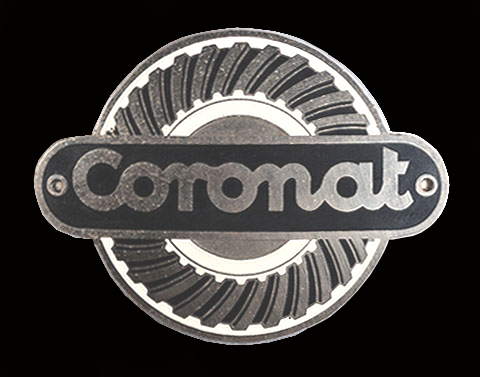
Coronat – the motorbike of Mallorca
There is a Latin phrase that illustrates this point very well: “Natura non dat, Salamanca non prestat” (What nature does not give, Salamanca does not grant). What that means is that those whom nature has not endowed with certain abilities (intelligence, inventiveness, good public speaking skills, etc), even if they graduate from the best university, will not acquire them.
But there is also the exact opposite: those who, without having attended a prestigious school or university , have brilliant inventiveness.
This is the case of Jaume Llobera Morro, who had no engineering training, but possessed an impressive creative mind and, in addition to many other inventions, designed and manufactured the Coronat motorbike in Mallorca.

The character
He was born in 1912 in Inca, a town in the centre of Mallorca with a long tradition of shoe manufacturing. Jaume Llobera devoted his professional life to the maintenance and repair of machinery for the footwear industry, but his imagination and abilities went far beyond that. He designed and manufactured several machines that greatly streamlined the shoe-making process, and he didn’t stop there, as he also improved a type of ship propeller, among many other inventions. His family was known in the town by the nickname “Coronat”, which he gave to his flagship project, a motorcycle that was very advanced for its time.
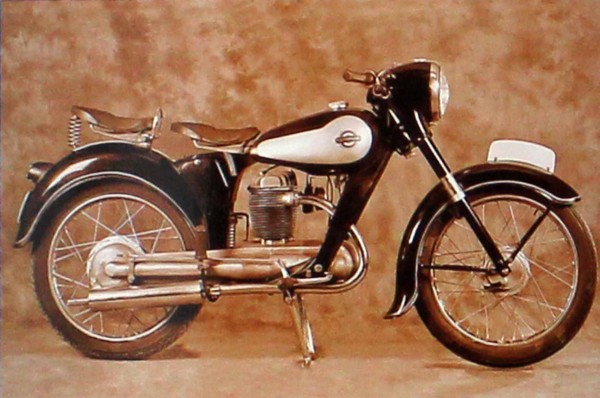
Period
In the 1950’s, Spain was already overcoming the calamities of the post-war period, the economy was picking up and people needed greater personal mobility. Cars were prohibitively expensive, but motorcycles and scooters were an ideal, practical and economical solution. Countless entrepreneurs and industrialists sprang up across the country and decided to manufacture motorcycles. There were models of all kinds, some better, some worse, some with imported engines, and many the result of enthusiasm for a business project that was expected to be very profitable. But in many cases, they lacked good commercial, financial, or even technical planning, and in the long run, they disappeared.
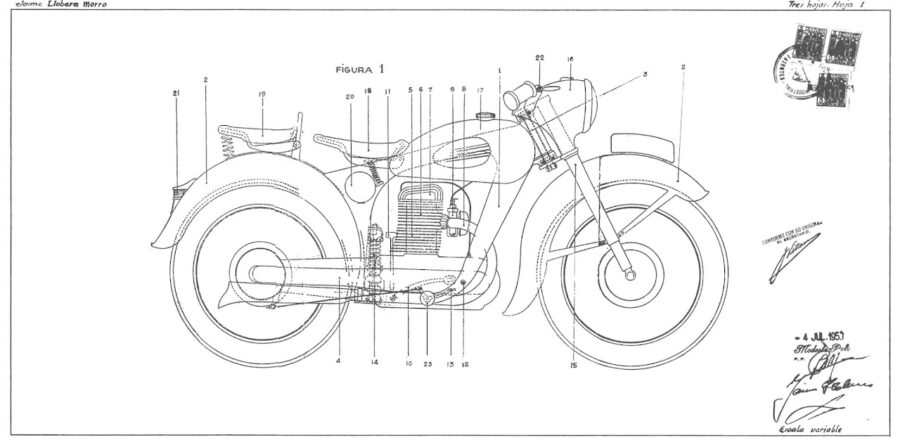
The motorbike, the project
Jaume Llobera also saw a great opportunity in the sale of motorcycles. He set about designing and manufacturing a high-quality model, far superior to any other domesrtically produced motorcycle: the Coronat.
For those who are not particularly fond of motorcycling, this machine may seem like just another old bike, but technical enthusiasts will appreciate its highly advanced technical solutions for its time. Some of these are only used in current high-end brands or models. Let’s take a look.
The technique
*Chasis
The norm at the time was a welded tube frame, but Coronat opted for stamped sheet metal. A self-supported “H”-shaped, in which the engine itself is part of the structure.
*Engine
Back then, in the 1950’s, the vast majority of brands that emerged in Spain used simple 2-stroke engines, often buying these engines abroad or simply copying them. It was the most economical option. Jaume Llobera was much more adventurous, not also designing but also manufacturing his own engine, a sophisticated 4-stroke.
This engine had a displacement of 200 cm3, a power output of aroun 10 horsepower and a 3-speed gearbox. All this allowed it to reach a top speed of around 110 km/h with moderate fuel consumption of around 2.5 litres of petrol.
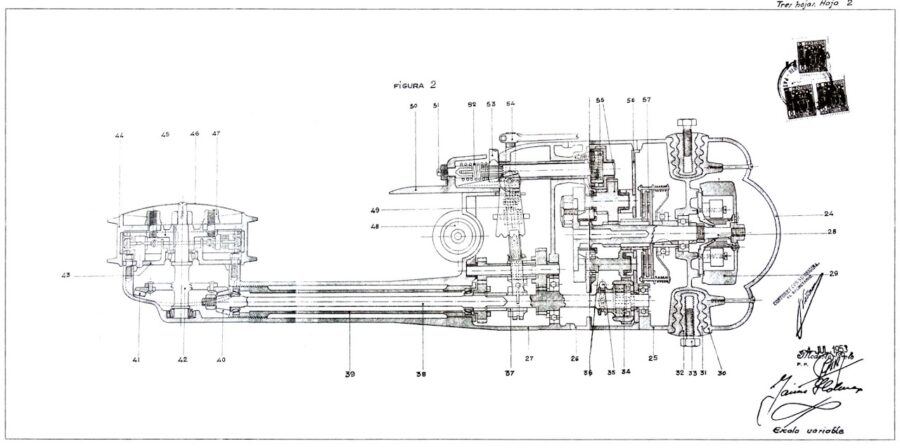
*Change and transmission
The 3-speed gear change is operated with the left foot, but once again, the amazing thing about this invention is the transmission system. The most common method was, and still is, a chain that transfers power from the engine to the rear wheel. But the Coronat was designed with a rear sprocket and crown gear transmission shaft. This is similar to what cars use, and is much cleaner and requires less maintenance than the typical chain.
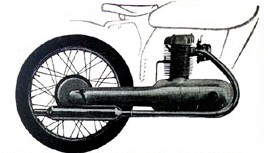
*Swing arm
Perhaps what is most striking to the eye is the combination of the engine, gearbox and swing arm, wich houses the transmission inside. All of this forms a solid, highly integrated and functional monoblock, giving the Coronat a very clean and modern design.
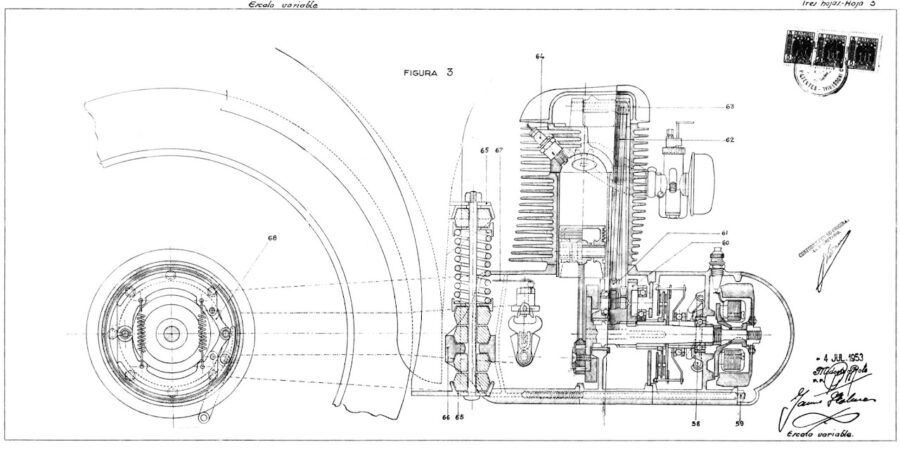
*Rear suspension
The rear suspension does not have two shock absorbers, one on each side of the wheel, as was normal at the time, but only one central shock absorber, as in most modern motorcycles.
*Rear wheel
Another brilliant solution … thanks to the single-sided swing arm and central shock absorber, the rear wheel is very accessible and can be removed just like on a car, simply by unscrewing four bolts.
*Other peculiar details
The location of the cylinder (central), carburettor and exhaust, lever and start-up mechanism… the motorcycle is full of details that demostrate Jaume Llobera’s genius. He did not want to follow what everyone else was doing, but allways sought his own path, with unique and innovative ideas.
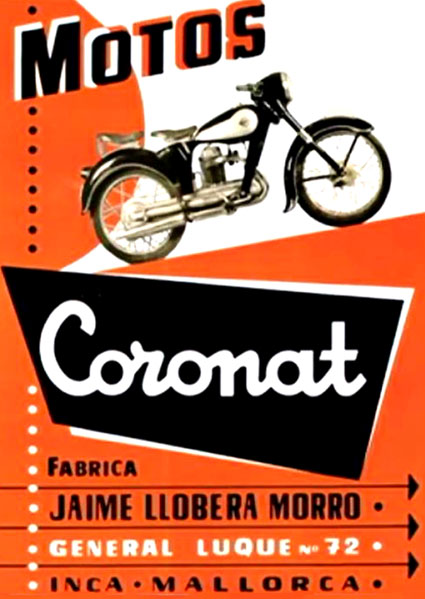
Outcome and ending of the story
Looking back, the project was a technical success but a commercial failure. The whole approach was designed to sell a lot of units, but barely seven motorcycles were sold in two years, from 1955 to 1957. Each unit sold for around 23.000 pesetas, which was a more than reasonable for a motorcycle of this kind, and it was probably the limitedcommercial distribution network that hampered sales. Ultimately his business partner’s financing tell through and Jaume Llobera had to abandon the project.
Despite being a great engineer, he failed in the economic and commercial spheres, and so he had to return to devoting himself fully to footwear machinery and other inventions.
How many Coronat are there currently?
We have records showing that seven Coronat motorcycles were registered, the first in 1955 (PM-10.521) and the last in 1957 (PM-22.572).
It is currently unknown where all of them have ended up, but both the Spanish Motorcycle Museum in Alcalá de Henares and the Motorcycle Museum in Basella (Lérida) have examples in their collections.
Conclusion
Perhaps if a highly inventive person like Jaume Llobera had been born and lived in a more industrialised area, such as Catalonia or the Basque Country, rather than on a small island like Mallorca, he would have had many more technical and financial resources at his disposal. We will never know how far he could have gone, but let us foucs on this and and admire the wonderful machine he left us, the Coronat.
If you liked this post, and you are interested in knowing more about the other brands of motorcycles that were produced in Mallorca, follow the link:
